When deciding on the look and feel for your roof, you may be wondering, “what material is best for roofing?” Or, you may be curious about the most common roofing material. Selecting a roof is a big deal so it’s understandable to have questions. After all, the right roof will add value and beauty to your home. According to the National Roofing Contractors Association, “It’s really an opportunity to upgrade your home in terms of look, style, and color.”
There are several different types of material you can typically choose from when it comes to your residential roof. Each type of roofing material provides its own degree of longevity, durability, and visual appeal. While you may be curious about the best material for roofing, as a homeowner, you must decide which will best serve your home, climate, and budget. In fact, before deciding on a material, there are things to consider in relation to your home:
- How heavy is this material and will it require special framing for your home?
- Is the material of your choice in line with your neighborhood/ HOA requirements?
- Does this material require any special installation or maintenance?
- Will the material you choose provide superior performance in the extreme weather conditions often found where you live?
- What is the cost, life span, and warranty for this product?
To help you make the right decision, here are some of the most common types of residential roofing materials- along with the pros and cons for each option.
Asphalt Shingles
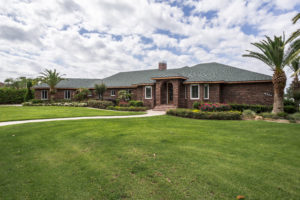 Did you know that approximately 80% of the residential roofs in North America are shingle roofs? While there are different types of shingles, the most common of those would be asphalt shingles. With an average lifespan of 20 years, asphalt shingles are the most affordable type of roofing material.
Did you know that approximately 80% of the residential roofs in North America are shingle roofs? While there are different types of shingles, the most common of those would be asphalt shingles. With an average lifespan of 20 years, asphalt shingles are the most affordable type of roofing material.
Also known as “composition shingles,” asphalt roofing is low-maintenance, easy to install, and available in several color options. However, it is also the weakest form of roofing material. With that being said, the right installation method, paired with regularly scheduled professional maintenance, can extend the lifespan and durability of your shingle roof considerably.
Clay and Concrete Tiles
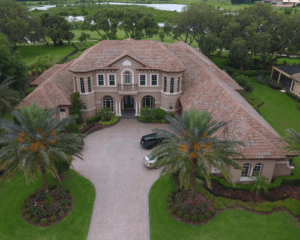 Whether you choose clay or concrete, tile will add elegance and texture to your roof. More so, tiles are long-lasting and fireproof. Additionally, concrete tiles are energy efficient. Between the two, concrete tiles are known for being more versatile and more affordable than clay. When properly maintained, tiles have an average life span of 40 to 50 years, with many lasting much longer.
Whether you choose clay or concrete, tile will add elegance and texture to your roof. More so, tiles are long-lasting and fireproof. Additionally, concrete tiles are energy efficient. Between the two, concrete tiles are known for being more versatile and more affordable than clay. When properly maintained, tiles have an average life span of 40 to 50 years, with many lasting much longer.
More expensive than asphalt, clay and concrete tiles are available in a variety of designs, shapes, and colors. However, as they are significantly heavier than shingle, your home may require additional framing. It is imperative to consult with a professional contractor to be certain a tile roof won’t do more harm than good after it is installed.
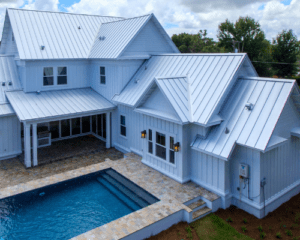 Metal Roofing
Metal Roofing
Architect Amy Alper describes a metal roof as, “…sleek, lightweight, long-lasting and recyclable.” Metal roofs are notorious for their resistance to severe weather – particularly as they offer the best protection against hurricane force winds. Made of aluminum, copper, stainless steel, or zinc, metal roofing can be installed in either panels or shingles. While more expensive than many roofing materials, metal roofing can last approximately 50 years. However, with the proper maintenance, metal roofs have been known to last up to 75 years.
Slate Roofing
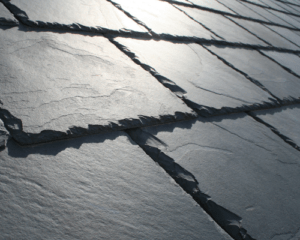 Slate is known for the beautiful and distinctive aesthetic it offers- particularly for Colonial, European and French chateau homes. In addition to the elegance it can provide a home, slate is also durable, fire-resistant, and is a sustainable material that can be recycled.
Slate is known for the beautiful and distinctive aesthetic it offers- particularly for Colonial, European and French chateau homes. In addition to the elegance it can provide a home, slate is also durable, fire-resistant, and is a sustainable material that can be recycled.
As it is made from stone, slate is understandably heavy. It may almost certainly require additional framing for any house that was originally built with another roofing material. With that being said, slate has been known to have a lifespan of up to 100 years and will offer additional protection against nature’s most brutal elements. It is important to be mindful that quality can vary with imported slate so be sure to select a vendor with a proven track record of slate installations.
Wood Shingles
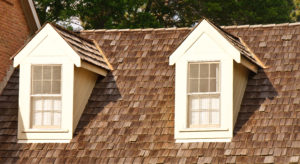 When considering wood shingles, it is essential to consider the elements your home experiences regularly. For example, if you live in a fire-prone region, you may want to avoid wood shingles. In fact, the fire code in your area may prohibit the use of wood shingles entirely. Additionally, in a wet region, such as Florida, the constant moisture can cause wood shingles to split, mold or rot.
When considering wood shingles, it is essential to consider the elements your home experiences regularly. For example, if you live in a fire-prone region, you may want to avoid wood shingles. In fact, the fire code in your area may prohibit the use of wood shingles entirely. Additionally, in a wet region, such as Florida, the constant moisture can cause wood shingles to split, mold or rot.
However, if climate or natural elements are not a concern, wood shingles offer a rustic, natural product that is often made from cedar, redwood, or southern pine. Wood shingles often compliment cottages, bungalows, and Tudor homes.
Bonus: Synthetic Roofing
Shaped to resemble natural roofing materials, synthetic products are often blended from rubber, plastic, fiberglass and fiber cement. They create strong, easy to maintain roofing materials. While these materials are designed to be stronger and less expensive than natural materials, they haven’t been in the market as long and aren’t as time-tested as other materials we’ve discussed.
Specifically, there may be little information on how they would potentially perform in your area. If considering a synthetic roof, it is important to check out full-size samples of the synthetic material, while also inquiring about any warranties being offered by the manufacturer.
Consult with Roofing Professionals
A quality roof is an important investment for your home. To help you get the best return on your investment, it is advised to work with a roofing expert. Whether you are simply looking to change shingle colors, or upgrade from a shingle roof to tile or metal, Roof Commander can answer any questions you may have. Roof Commander is here to help. We are experienced in all types of roof installation, repair, and maintenance- while also having a deep understanding of what works best in your area.